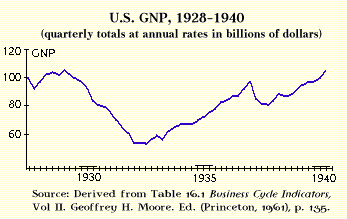

Actually, it did. it helped make it deeper and longer.
As did many other Big Government policies.
https://fee.org/articles/the-smoot-hawley-tariff-and-the-great-depression/
“We believe many modern economists are wrong because flawed modeling leads to two systematic understatements of the tariff’s negative effects. The first reason for this is that reliance on macro aggregates can sometimes mask serious underlying problems by dissipating their apparent impact over a broad area. For example, U.S. national income declined 36 percent in real terms from 1929 to 1933, and the view held by prominent economists, ranging from University of Chicago Nobel laureate Robert Lucas and Yale economist Robert Shiller to MIT economists Rudiger Dornbush and Stanley Fischer, is that since the foreign-trade sector was only about 7 percent of gross national product (GNP), the tariff (though misguided) could not explain much of this decline.
“Viewed at the level of “macro magnitudes,” critical micro connections suffer from a “dissipation effect” and always look small. But size does not equal significance. While it is true that foreign trade represented only a small percentage of the overall domestic and international economy, it does not follow that the tariff was insignificant in its effects. The Panama Canal contains but a small fraction of the world’s ocean water, but if it were closed the effects would be quite devastating to world trade. A focus on aggregates risks missing the trees for the forest, and not all trees are created equal.
“Here’s a second way Smoot-Hawley is underestimated: If regulations or tariffs are studied in partitioned models, their interrelationships are missed and their true impacts are trivialized. For example, recent attempts have been made to quantify price distortions caused by the tariff. Mario Crucini and James Kahn have tried to correct systematic underestimates of the harm of Smoot-Hawley found in a variety of macro studies that ignored the effect of tariff retaliation on the rate of capital accumulation. Using a general-equilibrium model, they calculate that the microeconomic distortion effects reduced U.S. GNP by only 2 percent in the early 1930s. Likewise economist Douglas Irwin computed the general-equilibrium inefficiencies caused by the tariff at nearly 2 percent of GNP.
“For instance, the secondary financial markets, such as the New York Stock Exchange, crashed twice during the last eight months of Smoot-Hawley’s legislative history. Jude Wanniski and Scott Sumner have linked concern over the impending tariff to the October 1929 crash and the June 1930 crash. The Dow Jones Industrial Average fell 23 percent in the first two weeks of June 1930 leading up to President Herbert Hoover’s signing the bill into law. On June 16 Hoover claimed, “I shall approve the tariff bill,” and stocks lost $1 billion in value that day—a huge sum at the time.
“Furthermore, if losses of GNP were not evenly distributed across the economy but were concentrated (say, in export-oriented states), the tariff most likely distorted monetary conditions significantly. Two percent of GNP does not sound like a big change, but if it’s concentrated in one-fifth to one-third of the states, it’s very large indeed. The tariff dramatically lowered U.S. exports, from $7 billion in 1929 to $2.4 billion in 1932, and a large portion of U.S. exports were agricultural; therefore it cannot be assumed that the microeconomic inefficiencies were evenly distributed. Many individual states suffered severe drops in farm incomes due to collapsing export markets arising from foreign retaliation, and it’s no coincidence that rural farm banks in the Midwest and southern states began failing by the thousands.
“Agriculture was not the only export sector destroyed by the tariff. The worldwide retaliation against U.S. minerals greatly depressed income in mining states and can be partially blamed for the collapse of the Wingfield chain of banks (about one-third of the banks in Nevada, with 65 percent of all deposits and 75 percent of commercial loans). U.S. iron and steel exports decreased 85.5 percent by 1932 due to retaliation by Canada. The cumulative decrease in those exports below their pre-tariff levels totaled $369 million. Is it any wonder that Pittsburgh saw 11 of its largest banks, with $67 million in deposits, close in September 1931? How about U.S.-made automobiles? European retaliation raised tariffs so high that U.S. exports declined from $541 million per year to $97 million by 1933, an 82 percent drop! Thus there was a cumulative export decline of $1.57 billion from the pre-tariff volume to 1933. Is it any wonder that the Detroit banking system (tied to the auto industry) was in complete collapse by early 1933?”